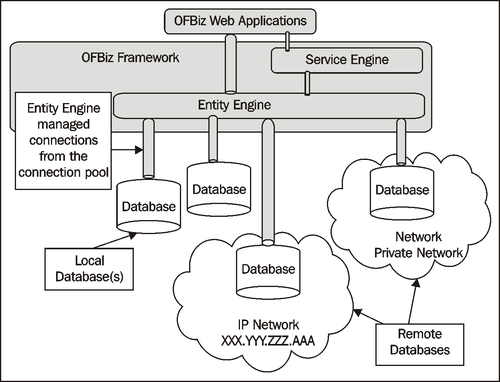In this chapter, we shall examine the following Entity Engine data management topics:
- Changing the default database from Derby to another data source
- Connecting to a remote database
- Connecting to multiple databases
- Creating entity groups
- Disabling automatic database checks on OFBiz startup
- Mapping database data types
- Creating a new entity definition file
- Creating a new entity model
- Modifying an existing entity model
- Building a view-entity
Secure and reliable data storage is the key business driver behind any data management strategy. That OFBiz takes data management seriously and does not leave all the tedious and error-prone data management tasks to the application developer or the integrator is evident from the visionary design and implementation of the Entity Engine.
The Entity Engine is a database agnostic application development and deployment framework seamlessly integrated into the OFBiz project code. It handles all the day-to-day data management tasks necessary to securely and reliably operate an enterprise. These tasks include, but are not limited to support for:
- Simultaneously connecting to an unlimited number of databases
- Managing an unlimited number of database connection pools
- Overseeing database transactions
- Handling database error conditions
The true power of the Entity Engine is that it provides OFBiz Applications with all the tools, utilities, and an Application Programming Interface (API) necessary to easily read and write data to all configured data sources in a consistent and predictable manner without concern for database connections, the physical location of the data, or the underlying data type.
To best understand how to effectively use the Entity Engine to meet all your data storage needs, a quick review of Relational Database Management Systems (RDBMS) is in order:
- RDBMS tables are the basic organizational structure of a relational database. An OFBiz entity is a model of a database table. As a model, entities describe a table's structure, content format, and any applicable associations a table may have with other tables.
- Database tables are further broken down into one or more columns. Table columns have data type and format characteristics constrained by the underlying RDBMS and assigned to them as part of a table's definition. The entity model describes a mapping of table columns to entity fields.
- Physically, data is stored in tables as one or more rows. A record is a unique instance of the content within a table's row. Users access table records by reading and writing one or more rows as mapped by an entity's model. In OFBiz, records are called entity values.
- Keys are a special type of field. Although there are several types of keys, OFBiz is primarily concerned with primary keys and foreign keys. A table's primary key is a column or group of columns that uniquely identifies a row within a table. The value of the primary key uniquely identifies a table's row throughout the entire database.
- A foreign key is a key used in one table to represent the value of a primary key in a related table. Foreign keys are used to establish unique and referentially correct relationships between one or more tables.
- Relationships are any associations that tables may have with one another.
- Views are "virtual" tables composed of columns from one or more tables in the database. OFBiz has a similar construct (although it differs from the traditional RDBMS definition of a "view") in the view-entity.
Note
Note: while this discussion has focused on RDMS, there is nothing to preclude you from using the Entity Engine in conjunction with any other types of data source(s).
The Entity Engine provides all the tools and utilities necessary to effectively and securely access an unlimited number of databases regardless of the physical location of the data source, as shown in the following figure:

